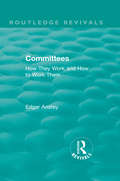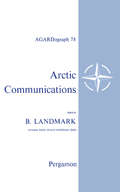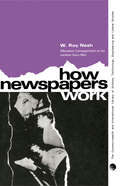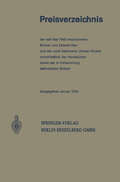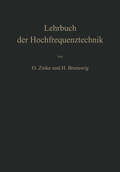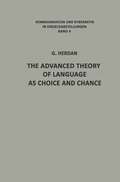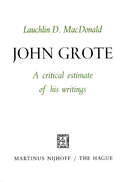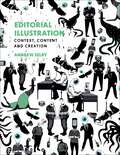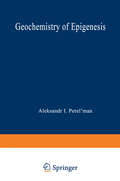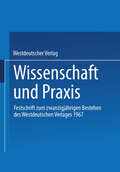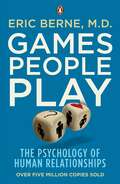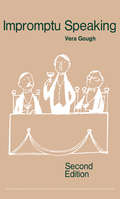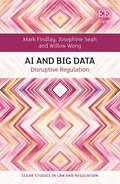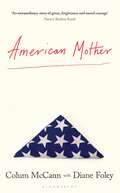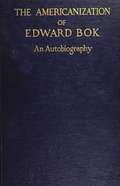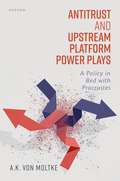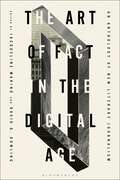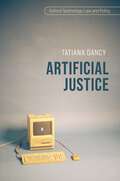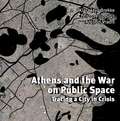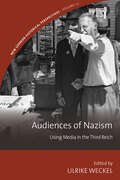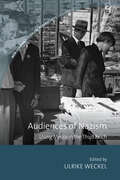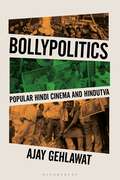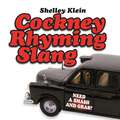- Table View
- List View
Routledge Revivals: How They Work and How to Work Them (Routledge Revivals)
by Edgar AnsteyFirst published in 1963, Edgar Anstey’s work gives a detailed account on the inner workings of the committee. Within a committee, different interests nearly always need to be represented when a decision must be taken, and contributions are required from people of different outlook or expert knowledge. A committee is often the only means of achieving a workable solution to a problem. This book attempts to analyse the functioning of different kinds of committee groups and to bring out the factors which make for efficiency and inefficiency. Types of committee and their purpose are discussed, as well as how to lead a discussion to bring out a genuine group view, the roles of chairman and secretary, how individuals influence committee decisions, good and bad tactics, and how to deal with difficult members.
Arctic Communications: Proceedings of the Eighth Meeting of the AGARD Ionospheric Research Committee, Athens, Greece, July 1963
by B. LandmarkArctic Communications is a compilation of the proceedings of the Eighth Meeting of the Ionospheric Research Committee of NATO's Advisory Group for Aeronautical Research and Development, held in Athens, Greece in July 1963. The meeting provided a forum for discussing advances in communications equipment used to conduct research in the Arctic and covered a wide range of topics such as the physical properties of the Arctic ionosphere; Arctic high-frequency communications; soundings and field strength measurements; and observations in the Arctic during nuclear tests. This book is comprised of 25 chapters and begins with a discussion on experimental studies of high latitude absorption phenomena, including auroral absorption, polar cap absorption, and sudden commencement absorption. Direct measurements of D-region electron densities during the absorption periods are also presented. Subsequent chapters focus on the ionospheric absorption of cosmic noise observed at geomagnetically conjugate points; ionospheric ionization produced by solar flares; military communication facilities in the Canadian Arctic; and radio noise problems in Arctic regions. Phase instabilities on a very-low-frequency transmission path passing through the auroral zone are also considered. This monograph will be of particular value to scientists and researchers with interest in the Arctic.
How Newspapers Work: The Commonwealth and International Library: Liberal Studies Division
by W. Roy NashHow Newspapers Work is a detailed account of how newspapers work, with emphasis on the mechanics of news gathering and tasks of the reporter, sub-editor, news specialists, and editor. A typical day in the life of a morning newspaper is described, and the role of the press in society is examined. This book is comprised of seven chapters and begins with an introduction to the history of newspapers, with particular reference to some ""popular"" national daily newspapers in Britain such as the Daily Express, Daily Mail, Daily Herald, Daily Mirror, and Daily Sketch. The next chapter focuses on the role of reporters in gathering news, their education and training, and qualities of a good reporter. Subsequent chapters look at the main tasks of sub-editors, news specialists such as columnists, and editors. The penultimate chapter describes a typical day in the life of a morning newspaper, while the last chapter considers the social and political aspects of the press. This monograph will be of interest to journalists and those considering a career in the newspaper industry.
Preisverzeichnis: der seit Mai 1945 erschienenen Bücher und Zeitschriften und der noch lieferbaren älteren Bücher einschließlich der Handbücher sowie der in Vorbereitung befindlichen Bücher
by Berlin SpringerThe Advanced Theory of Language as Choice and Chance (Communication and Cybernetics #4)
by Gustav HerdanIn trying to give an account of the statistical properties of language, one is faced with the problem of having to find the common thread which would show the many and multifarious forms of language statistic- embodied in scattered papers written by linguists, philosophers, mathe maticians, engineers, each using his own professional idiom - as belong ing to one great whole: quantitative linguistics. This means that the investigator has to find the system of this branch of science which would enable him to arrange the vast material in an orderly fashion, and present it as an organic whole. Such a system is conceived in this book, as comprising the following disciplines as the four main branches of literary statistics: Statistical Linguistics, Stylostatistics, Optimal Systems of Language Structure, and Linguistic Duality (Parts I-IV). The Introduction is meant to define the position of the book with regard to both, linguistics and statistics.
John Grote: A Critical Estimate of his Writings
by Lauchlin D. MacDonaldAn objective of this book is to discuss some of the contributions made by John Grote to philosophy. This work is an extension of a dissertation written for the doctorate at Boston University. The author wishes to acknowledge the invaluable assistance in many places to Professor Peter A. Bertocci and the late Professor Edgar S. Brightman both of whom read the entire manuscript in its original form. Also, the author acknowledges the encouraging interest and support of his wife, Helen, whose many suggestions have improved the writing and without whose assistance this work would not have been accomplished. The author assumes complete responsibility for whatever errors or deficiencies appear in the book. All known writings of Grote are listed and the more important ones analyzed. LAUCHLIN D. MACDONALD CHAPTER I INTRODUCTION 1. JOHN GROTE'S LIFE i. Sketch of his life John Grote will remain best known by reason of the thought formu lated in the Exploratio Philosophica, or Rough Notes on Modern I ntellectu al Science. To the philosophical world of his own time he was well known as the teacher who ably held the chair of Moral Philosophy in the University of Cambridge from r855 until the year of his death, r866, to the Knightbridge Professor, William Whewell whose in succession Philosophy of Science is the subject of at least one chapter of the Exploratio Philosophica. Grote's birthplace was Beckenham in Kent, and the date, May 5, r8r3.
Editorial Illustration: Context, content and creation
by Andrew SelbyAcross digital and print media, editorial illustrators create visuals to support text and convey ideas, but there is more to these illustrations than meets the eye.Internationally-recognised illustrator and educator Andy Selby takes you through the importance of context and content when responding to editorial illustration briefs, explaining how understanding of visual communication concepts leads to more successful illustrations - all while under the time pressure of editorial briefs. Covering ideation, development and execution, this book includes:- A short history of illustration as a political and social tool- How to use visual language, symbolism and satire and to what purpose- Representation of identity, ethics and society - both for impact and sensitive designs- Research, commercial judgement and experimentation- Professional conduct, self-promotion, responsibilities and plagiarism So whether you're illustrating a news story, summarising new scientific discoveries or creating an image for a magazine cover, Editorial Illustration will give you the skills to produce striking commercial designs on time and to brief.
Geochemistry of Epigenesis (Monographs in Geoscience)
by A. I. Perel manIn its classical sense "epigenesis" refers to all geological processes originating at or near the surface of the earth. It thus embraces all those phenomena which we associate with the land scape; Perel'man has already written extensively on this subject. The landscape, in the physical sense, is controlled by the interac tion of exogenic and endogenic agencies-on the one hand, the atmo sphere, the wind, the rain, and other components of the weather, the forces of running water and the planetary controls of gravitational and tidal nature; and on the other hand the materials of the earth's crust, from sediments to metamorphic rocks and igneous materials from deep endogenic sources. In practical terms the epigene region involves the products of weathering, the soils, the transported material, the colluvium of hillsides, and the alluvium of stream valleys. It involves those landforms that are products of the erosional sculpturing of the landscape, as well as those that result from accumulation, such as glacial moraines and desert sand dunes. The science of geomor phology is gradually beginning to evolve from a passive cataloging of scenery and its deduced causes (in the Davisian sense) into a vigorous study of dynamic processes. These are partly geophysical, in the sense of hydraulics and mechanical studies, and partly geo chemical.
Wissenschaft und Praxis: Festschrift zum zwanzigjährigen Bestehen des Westdeutschen Verlages 1967
by Westdeutscher VerlagGames People Play: The Psychology of Human Relationships
by Eric BerneDo you realise you, and all the people you know, play games? All the time? Sexual games, marital games, complex games that you’re not even aware of as you go about your usual life? You might play games like ‘Alcoholic’ or ‘The Frigid Woman' at weekends, or perhaps 'Ain't it awful' or ‘Kick me’ while you’re at work.First published in the 1960s and recognized as a classic work of its kind by professionals, the bestselling ‘Games People Play’ is also an accessible and fascinating read. It is a wise, original, witty and very sensible analysis of the games we play in order to live with one another – and with ourselves.
Impromptu Speaking
by Vera GoughImpromptu Speaking, Second Edition provides a time-saving method and a guide for the type of speech anyone might make. The book, in particular, covers how to make short speeches in a conversational way. Organized into four chapters, the book begins with an explanation of confidence in speechmaking. The role that sense of humor plays in a speech is also addressed. Subsequent chapter elucidates the five-point plan, which corresponds to the fingers and thumb of one hand. In studying the plan, no. 1 (little finger) always refers to the occasion, and no. 5 (thumb) always refers to the purpose of it. Then, with practice, notes are written against 2, 3, and 4 only. In the last chapter, plans and examples are given. This book will be helpful to anyone who will make an impromptu speech.
AI and Big Data: Disruptive Regulation (Elgar Studies in Law and Regulation)
by Mark Findlay Josephine Seah Willow WongThis provocative and timely book identifies and disrupts the conventional regulation and governance discourses concerning AI and big data. It suggests that, instead of being used as tools for exclusionist commercial markets, AI and big data can be employed in governing digital transformation for social good. Analysing the ways in which global technology companies have colonised data access, the book reveals how trust, ethics, and digital self-determination can be reconsidered and engaged to promote the interests of marginalised stakeholders in data arrangement. Chapters examine the regulation of labour engagement in digital economies, the landscape of AI ethics, and a multitude of questions regarding participation, costs, and sustainability. Presenting several informative case studies, the book challenges some of the accepted qualifiers of frontier tech and data use and proposes innovative ways of actioning the more conventional regulatory components of big data. Scholars and students in information and media law, regulation and governance, and law and politics will find this book to be critical reading. It will also be of interest to policymakers and the AI and data science community.
American Mother
by Colum McCann Diane Foley'An extraordinary story of grace, forgiveness and moral courage' Patrick Radden KeefeA 2024 HIGHLIGHT IN THE OBSERVER, GUARDIAN AND IRISH TIMESThe English language has no specific word for the parent that has lost a child. There exist words for orphan, widow and widower, but there is no word that captures and conveys this tragic type of loss. It has been eleven years since Diane Foley's son, the American journalist James Foley, was kidnapped in northern Syria, and nearly ten since that day in August 2014 when she would learn that he had been murdered by ISIS in a public beheading that would ricochet in video around the world. A whole decade. Time rushes past. And yet, for Diane, that moment is unending. In American Mother, legendary author Colum McCann tells Diane's story as she recalls the months of his captivity, the efforts made to bring him home and the days following his death, in which Diane came face to face with one of the men responsible for her son's kidnapping and torture. A testament to the power of radical empathy and moral courage, American Mother takes us inside one woman's extraordinary journey to find connection in a world torn asunder, and to fight for others as a way to keep her son's memory alive.
The Americanization of Edward Bok: The Autobiography of a Dutch boy Fifty Years After
by Edward BokEdward William Bok (born Eduard Willem Gerard Cesar Hidde Bok) (October 9, 1863 – January 9, 1930) was a Dutch-born American editor and Pulitzer Prize-winning author. He was editor of the Ladies' Home Journal for 30 years (1889-1919). <P><P> Pulitzer Prize Winner
Antitrust and Upstream Platform Power Plays: A Policy in Bed with Procrustes
by A.K. von MoltkeLarge digital platforms have been in the doghouse of antitrust decision-makers worldwide in recent years. Antitrust regulators agree, urgent intervention is needed. Interestingly, it is the plight of victimized suppliers—of merchants, app developers, publishers, platform labourers, and the like, who are upstream in the value chain—that has topped the policy agenda, prompting scrutiny of an almost unprecedented intensity. Amid such anxieties, Antitrust and Upstream Platform Power Plays asks a somewhat provocative question: Are upstream platform power plays really 'competition problems', and ones for antitrust, at that? The apparently obvious answer—'yes'—is deceptively simple for a number of reasons. Firstly, it contradicts contemporary antitrust's single-minded focus on consumers, which has all but erased supplier exploitation in the brick-and-mortar economy from the policy's radar. Secondly, the wider antitrust community remains bitterly divided when it comes to judging platform practices. In addition, if any consensus could be had, it would almost certainly confirm the longstanding tenet that antitrust cannot be about supplier welfare, as such. These paradoxes call for a policy introspection-precisely what this book provides. The analysis offered in Antitrust and Upstream Platform Power Plays is altogether normative, theoretical, and practical. Normative because it engages in a supplier-mindful soul-searching exercise, which advances our understanding of antitrust's foundations; theoretical as it sheds multidisciplinary insights on upstream effects in the platform economy and develops new frameworks for rationalizing them; and practical since it takes a deep dive into the complex antitrust machinery whilst staying attuned to other available levers of public action. Answering a compelling question with an equally compelling answer, this work will appeal to scholars and policymakers worldwide with a particular interest in platform regulation, antitrust, and powerful digital platforms.
The Art of Fact in the Digital Age: An Anthology of New Literary Journalism
The Art of Fact in the Digital Age is a showcase of the most powerful and moving journalism of the past 25 years. Selections include stories originally published in established bastions of literary journalism (The New York Times, The Atlantic and The New Yorker), as well as those from specialized and online publications (Runner's World, The Atavist). It features writers of extraordinary style (including Carina del Valle Schorske, Brian Phillips, and Jia Tolentino), as well as those who have profoundly influenced public discourse on the 21st century's most urgent issues: Mitchell S. Jackson, Clint Smith, and Ta-Nehisi Coates on race; Susan Dominus and Luke Mogelson on migration; and Kathryn Schulz and David Wallace-Wells on environmental threats. It even includes one story that expanded literary journalism's repertoire into audio (This American Life). This collection, assembled for students, scholars, and practitioners alike, also charts the evolution of digital longform journalism through its greatest achievements, from transitioning readers to screens to the integration of multimedia with words in service of meaning. The art of fact in the 21st century opened new ranges of expression to address such issues, while uniquely bearing the imprint of their generation's digital cultures and technologies. Although many forces compete for attention in the digital age, story triumphs. The works in this anthology show us why.
Artificial Justice (Oxford Technology Law and Policy)
by Tatiana DancyImagine that Eric, a young man, has been convicted of a gang-related crime: he was found by police at the scene of a robbery carried out by his friends. The sentencing judge now needs to make a decision. Not knowing whether Eric poses a risk to the public, she turns to an algorithmic risk assessment - a set of rules, developed on the basis of correlations between individual characteristics and criminal activity, which predicts the likelihood of recidivism. Eric is a conscientious citizen, who has never before been in trouble with the law. However, he was raised in foster care, in an area with high rates of crime, poverty, and residential instability- facts to which the algorithm attributes a high risk score. The judge recommends a sentence of the maximum possible duration, with extended post-release supervision. Why does this matter? The answer most often given is that it matters because of inequality, captured through the language of 'bias' or 'discrimination': the effect of using algorithms can be to exacerbate unjustified differences between people, on the basis of considerations such as race, sex, or socio-economic circumstance. Using a diverse set of case studies, and making clear policy recommendations along the way, Artificial Justice unpacks the reasons that we might have to object to the use of statistical algorithms to allocate the burdens of policy decisions. It argues that these reasons extend beyond egalitarian concerns. Importantly, they include reasons that stem from the value of individual choice - of having the chance to affect what happens to us by choosing appropriately and being equipped to exercise those choices well. The book explores the substantive reasons that contribute to a picture of what's at stake for individuals when we use statistical algorithms to make decisions about how to treat others, and makes robust policy recommendations about the scope and nature of human-algorithm interaction. Artificial Justice is a compelling and accessible text, which offers a great deal to a wide and interdisciplinary audience of academics, students, and those otherwise interested in learning about algorithmic justice.
Athens and the War on Public Space: Tracing a City in Crisis (PDF)
by Klara Jaya Brekke Christos Filippidis Antonis VradisSometimes, the maelstrom of a crisis can be captured in a single image. The image of the mundane, barely noticeable movement of an urban dweller as they go about their everyday life. Athens and the War on Public Space commences from images just like this one, collected over a two-year period of research (2012–2014) in the Greek capital city. These images, gathered by a team of artist-researchers working to trace and study crisis-ridden urban public spaces in Athens, Greece, create a visual timeline for navigating through all that happened over those two troubled years. The resulting catalog shows how images of shipwrecks and disaster were used to harden anti-migratory policies, and how these exact policies then helped to foster the hatred that spilled onto the streets of Athens, in the form of racist attacks. Athens and the War on Public Space further outlines the violence inherent in the images of silent commuters going about daily life despite the catastrophe, caught in the freeze-frame of inaction as the world around them changes beyond recognition. The carefully curated images show how the crisis was quite literally played out in the city of Athens, especially vis-a-vis its performative construction in the images of anti-migratory policies, state repression, and their material, grave consequences. Athens and the War on Public Space is ultimately a collective portrait of a city caught in the whirlwind of crisis. The book is a compilation of work done during the larger Crisis-Scape project. The team comprised Klara Jaya Brekke, Dimitris Dalakoglou, Ross Domoney, Christos Filippidis, and Antonis Vradis.
Audiences of Nazism: Using Media in the Third Reich (New German Historical Perspectives #13)
Through its focus on audiences and their reception of media in Nazi Germany, Audiences of Nazism inverts the typical top-down perspective employed in studies that concentrate on the regime’s regulation of media and propaganda. It thereby sheds new light on the complex character of the period’s media, their uses, and the scope for audience interpretation. Contributors investigate how consumers either appropriated or ignored certain messages of Nazi propaganda, and how some even participated in its production. The authors ground their studies on novel historical sources, including private diaries and letters, photographs and films, and concert programs, which demonstrate, amongst other things, how audiences interpreted and responded to regulated news, Nazi Party rallies, and the regime’s denunciation of modern works of art as ‘degenerate.’
Audiences of Nazism: Using Media in the Third Reich (New German Historical Perspectives #13)
by Ulrike WeckelThrough its focus on audiences and their reception of media in Nazi Germany, Audiences of Nazism inverts the typical top-down perspective employed in studies that concentrate on the regime’s regulation of media and propaganda. It thereby sheds new light on the complex character of the period’s media, their uses, and the scope for audience interpretation. Contributors investigate how consumers either appropriated or ignored certain messages of Nazi propaganda, and how some even participated in its production. The authors ground their studies on novel historical sources, including private diaries and letters, photographs and films, and concert programs, which demonstrate, amongst other things, how audiences interpreted and responded to regulated news, Nazi Party rallies, and the regime’s denunciation of modern works of art as ‘degenerate.’
Bollypolitics: Popular Hindi Cinema and Hindutva (World Cinema)
by Ajay GehlawatThis book provides an in-depth exploration of the evolving landscape of Bollywood cinema in response to recent socio-political changes in India, including a surge in sectarian violence and the ascent of Hindutva, or Hindu nationalism, under Prime Minister Narendra Modi's leadership. Through a comprehensive analysis of prominent filmmakers and actors like Sanjay Leela Bhansali, Kangana Ranaut, Akshay Kumar, and Anupam Kher, Ajay Gehlawat investigates the extent to which their recent works align with key tenets of the Hindutva movement. He scrutinizes the growing influence of the Bharatiya Janata Party (BJP) on film production, manifesting in collaborations covering diverse themes, from Modi's Clean India initiative to the nation's space exploration endeavors and grand historical epics such as Padmaavat (2018) and Manikarnika (2019) that seek to reshape Indian history in line with Hindutva ideology.Gehlawat goes on to dissect smaller budget films like Article 15 (2019) and Shubh Mangal Zyada Saavdhan (2020), which tackle pressing social issues like caste-based violence and homophobia exacerbated by the surge in right-wing extremism in India. In doing so, he elucidates the profound and far-reaching impact of Hindutva ideology on Indian cinematic narratives and aesthetics, while also considering the broader implications for Indian society as a whole.
The Book in the Jewish World, 1700-1900 (The Littman Library of Jewish Civilization)
by Zeev GriesThis book offers the reader a voyage in the new world that opened up to the enlightened Jewish reader of the eighteenth and nineteenth centuries, a time when the first glimmerings of emancipation and secular education were giving large numbers of Jews their first exposure to science, literature, and art, and opening their minds to new ideas. And as on any voyage led by a knowledgeable guide, there are fascinating side-trips along the way: insights into the world of scholarship, then and now, and into the nature of knowledge. All this was happening at a time when Jews’ civil status and place in society was undergoing great change in Europe. In this seminal work, Zeev Gries shows that although the history of the book in the Jewish world has long been regarded as the province of librarians and bibliophiles, it is in fact the history of the Jewish intellect. He starts by tracing the awakening of a dormant Jewish intelligentsia—men, women, and children who were thirsty for knowledge. Books were the magic kiss that opened new doors to the modern world; within a century, Jews were making invaluable contributions to the advancement of science and of culture more generally. By surveying the literary output of those years, the author is able to discover what books were being published, where they were published and distributed, and who was reading them. He surveys the fields of halakhic literature, ethical literature, kabbalistic and mystical literature, literature for children and women, and more general literature. He talks about the role of libraries and of book reviews. Above all, he considers the role of books as agents of culture: were they guardians of hallowed sanctity or harbingers of secularization? Gries shows how the types of books favoured by the Jewish reading public offer an insight into the changing nature of their ‘portable homeland’. He then goes on to discuss the Haskalah movement and the tensions between increasing secularization and the more traditional world-view, as well as how the resurrection of Hebrew as a secular literary language contributed to the awakening of Jewish nationalism. Nevertheless, he argues that the study of literary history of the period reveals that secular and Zionist leanings were not the only trends present; Jewish literature continued to be permeated with the spirit of religion.
Christians and Moors in Spain, Volume I: AD 711-1150 (Aris & Phillips Hispanic Classics)
by Colin SmithThis volume gathers together extracts from texts in Latin, Hispanic vernaculars, and French, concerning the relations of the Christians and Moors in Spain in the first four hundred years of their co-existence in the Peninsula. An effort has been made to illustrate aspects other than the exclusively military. The texts are both historical and 'literary' (this distinction not being one that the medieval mind would make) and in both prose and verse; they are arranged in order of the events to which they refer, not by date of composition. The purpose is to make these texts available in a form not previously attempted, to all who are interested in this fascinating period, but may be unable to read the original languages or may not have access to the published sources. Each text has a facing translation and introductory section with notes on the background and on textual difficulties. There is also a general introduction and a short booklist.
Cockney Rhyming Slang
by Shelley KleinHave you ever been lost for words in the East End markets? Ever got your Gertie Gitanas (bananas) confused with your corns and bunions (onions) and it's all gone a bit Pete Tong (wrong)? Cockney Rhyming Slang is a quick, easy-to-use guide to some of the most frequently used, up-to-date as well as old-fashioned phrases.Including: 'apples and pears' - stairs 'Barnet Fair' - hair 'sausage and mash' - crash 'bubble bath' - laugh 'Britney Spears' - beers 'has beens' - greens 'dig a grave' - shaveAn entertaining collection that explains the ever-evolving dialect of London's East End, with Cockney Rhyming Slang you'll be conversing with the street traders of the East End with no Barney Rubble (trouble).
